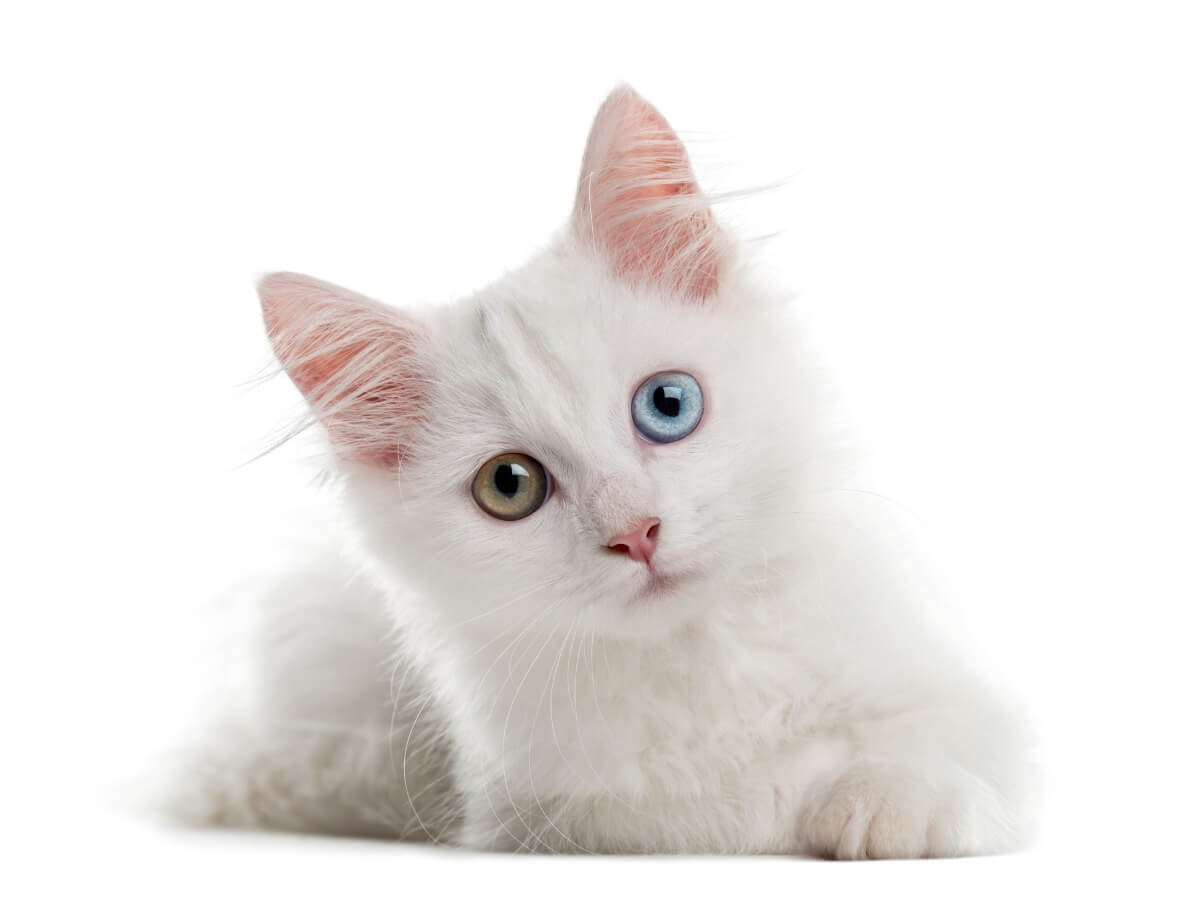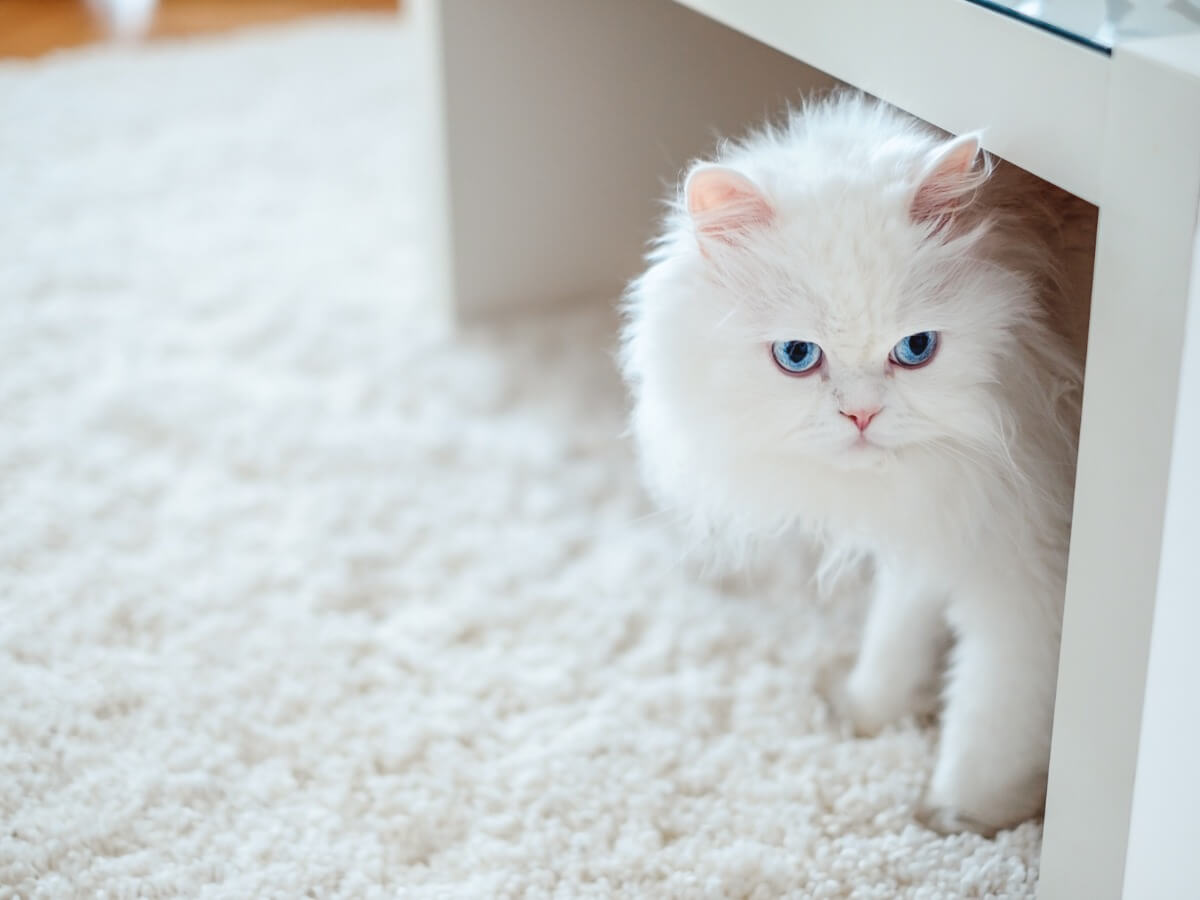Albino Cat Care


Reviewed and approved by the biologist Samuel Sanchez
Albino felines are not just white cats. In reality, only 2% of white cats are albinos, so it’s a condition that goes far beyond a hair color. Knowing and studying the care of the albino cat is a fundamental task if you want to adopt one of these specimens, as they require special and very different attention from other cats.
For a cat to be albino, it must carry a genetic alteration that differentiates it from other felids, including whites. Here you can learn more about the characteristics and care of the albino cat.
Characteristics of an albino cat
Albinism is caused by a genetic mutation responsible for the coding of tyrosinase, the main enzyme in the production of melanin. Studies comment that some gene mutations that influence coloration patterns (such as albinism) have been introduced to wild populations by the movement of genes from one species to another. This is possibly due to the return of domestic individuals to the wild, or by the hybridization of domestic relatives with wild ones.

How to differentiate a white cat from an albino cat?
White fur in felines can be caused by two mechanisms: albinism and leucism, terms that are frequently confused. Albinism is a congenital disorder characterized by the following signs:
- The lack of pigment in the coat, which is completely white
- The skin, ears, legs, lips, and eyelids are usually pink from a lack of pigmentation
- Their eyes (in almost all cases) are light blue, pink, or two-colored.
On the other hand, leucism is a genetic peculiarity due to a recessive gene that turns the coat white, while the tone of the skin and eyes remains normal. However, in both cases, the white coat is due to a lack of melanin.
Even the Siamese, Burmese, and Tonkinese cat breeds are forms of partial albinism, in which pigment is produced only on the extremities of the body, creating a dark mask on the face, legs, and tail. This type of albinism is known as pointed or himalayan.
Diseases in cats related to albinism
Felines with white fur and blue eyes often suffer from feline deafness. They’re also more prone to skin cancer, which appears mainly in the ears and nose. Due to these and other characteristics, albino cats must receive good care in order to prevent diseases.
Melanin protects the animal from the sun’s rays and its effects. The absence of this pigment favors the appearance of neoplastic processes.
However, these are not the only pathological processes that occur according to race. In Siamese cats, for example, it’s common for them to suffer from strabismus (the two eyes don’t line up in the same direction and therefore don’t look at the same object) and nystagmus (rapid and involuntary movements of the eyes).
Albino cats, in general, can suffer from immune system problems, because according to professional sources, melanin is important to keep this complex defense mechanism strong. Therefore, it’s believed that they’re more susceptible to infectious diseases and immunodeficiencies.
In addition, it’s also normal to notice that these cats bump into things frequently, as melanin helps to perceive depth at a visual level. Next, we’ll explain the most basic care and illnesses of cats with these characteristics.
Albino cat epidermis
La Fortuna veterinary group says that these cats don’t have melanic pigmentation and therefore are ultrasensitive to contact with the sun. Due to this, it’s recommended that you monitor their exposure to natural light and apply a special protector on their ears and nose, in order to avoid the development of skin cancer or burns on their epidermis.
Ask your trusted veterinarian for a special cream or sunscreen for cats to keep their skin protected and disease-free.
Blindness
Experts affirm that these cats’ eyes are very sensitive to strong light, both from the sun and from reflectors or other sources. This is because a lack of melanin leaves their eyes unprotected and defenseless against ultraviolet rays, which can cause blindness.
If you have an albino cat, be sure to monitor how long they spend in direct sunlight and consult a trusted veterinarian on how to properly care for their eye apparatus. Once damage occurs to the visual system, it’s very difficult to reverse the situation.
Deafness in albino cats
A white cat that has two blue eyes is 3-5 times more likely to be deaf, experts say, and a cat with only one blue eye is twice as likely. In addition, cats with two-colored eyes tend to have deafness in only one ear, as this is almost always associated with a blue eye.
When they have both blue eyes, apart from being deaf, albino cats can present photophobia, that is, they cannot stand bright light and their vision in the dark is usually reduced.
Deaf cats are very aware of vibrations from the ground and air. Communication between specimens, if the feline doesn’t live alone, is based on smell and visual signals, so its life is not usually greatly affected by this. Even so, it’s an issue that must be handled by vets in all cases.

Albino cats are beautiful and fascinating, but due to their genetic makeup they’re prone to certain conditions. If you want to get one of these felines, make sure you have enough experience and knowledge. Also, bear in mind that, perhaps, encouraging crossbreeding to give rise to these types of animals may be a question of dubious morality.
All cited sources were thoroughly reviewed by our team to ensure their quality, reliability, currency, and validity. The bibliography of this article was considered reliable and of academic or scientific accuracy.
Clancy, M. (2020, 16 septiembre). Albino Cats Are Not Just White Cats! Here’s How To Tell Them Apart. CatTime. https://cattime.com/cat-facts/24859-albino-cats-not-white-cats
Fortuna, L. (2021, 8 abril). Cómo reconocer a un gato albino y cuidados que necesita. Grupo Veterinario La Fortuna. https://www.grupoveterinariolafortuna.com/gato-albino/
Guevara, L., & Rubio, I. (2017). Variación en la coloración y los patrones del pelaje en los felinos. Investigación y Ciencia, 25(71), 94–101. https://www.redalyc.org/journal/674/67452917012/html/
Master, W. (2018, 10 enero). Los gatos blancos y la sordera. Gatos y Respeto. https://gatosyrespeto.org/2017/12/14/los-gatos-blancos-y-la-sordera/
Raza de gatos. (2021, 26 julio). Gatos Albinos: Características y cuidados. https://razadegatos.info/gatos-albinos-caracteristicas-y-cuidados/
This text is provided for informational purposes only and does not replace consultation with a professional. If in doubt, consult your specialist.